ThisiscontentfromElsevier'sDrugInformation
Phentermine-topiramate
Learn more about Elsevier's Drug Information today! Get the drug data and decision support you need, including TRUE Daily Updates™ including every day including weekends and holidays.
NOTE: Phentermine; topiramate is indicated as an adjunct in adults with obesity or who are overweight and have at least 1 weight-related comorbid condition (e.g., hypertension, diabetes mellitus, and dyslipidemia) and in pediatric individuals 12 years and older with obesity.[51256]
3.75 mg phentermine; 23 mg topiramate PO once daily for 14 days, then increase the dose to 7.5 mg phentermine; 46 mg topiramate PO once daily. If weight loss is not at least 3% of baseline weight after 12 weeks, increase the dose to 11.25 mg phentermine; 69 mg topiramate PO once daily for 14 days, and then 15 mg phentermine; 92 mg topiramate PO once daily. If weight loss is not at least 5% of baseline weight after another 12 weeks, discontinue therapy as it is not likely meaningful weight loss will be achieved and sustained with continued treatment. To discontinue the 15 mg phentermine; 92 mg topiramate dose, decrease dose to every other day for at least 1 week before stopping treatment altogether, to avoid precipitating a seizure.[51256]
3.75 mg phentermine; 23 mg topiramate PO once daily for 14 days, then increase the dose to 7.5 mg phentermine; 46 mg topiramate PO once daily. If weight loss is not at least 3% of baseline BMI after 12 weeks, increase the dose to 11.25 mg phentermine; 69 mg topiramate PO once daily for 14 days, and then 15 mg phentermine; 92 mg topiramate PO once daily. If weight loss is not at least 5% of baseline BMI after another 12 weeks, discontinue therapy as it is not likely meaningful weight loss will be achieved and sustained with continued treatment. Consider dosage reduction if weight loss exceeds 0.9 kg/week. To discontinue the 15 mg phentermine; 92 mg topiramate dose, decrease dose to every other day for at least 1 week before stopping treatment altogether, to avoid precipitating a seizure.[51256] [71238]
15 mg phentermine/92 mg topiramate extended-release PO daily.
15 mg phentermine/92 mg topiramate extended-release PO daily.
15 mg phentermine/92 mg topiramate extended-release PO daily.
12 years: 15 mg phentermine/92 mg topiramate extended-release PO daily.
1 to 11 years: Safety and efficacy have not been established.
Do not use.
Do not use.
Mild hepatic impairment (Child Pugh Class A): No dose adjustment required.
Moderate hepatic impairment (Child Pugh Class B): Do not exceed 7.5 mg/46 mg PO once daily.
Severe hepatic impairment (Child Pugh Class C): Avoid use.[51256]
CrCl 50 mL/minute or greater: No dose adjustment required.
CrCl less than 50 mL/minute: Do not exceed 7.5 mg/46 mg PO once daily.[51256]
Intermittent hemodialysis
Avoid use in patients with end-stage renal disease on dialysis.[51256]
† Off-label indication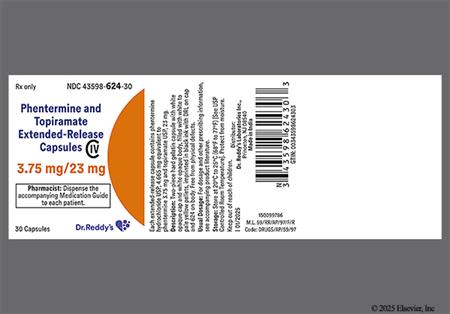
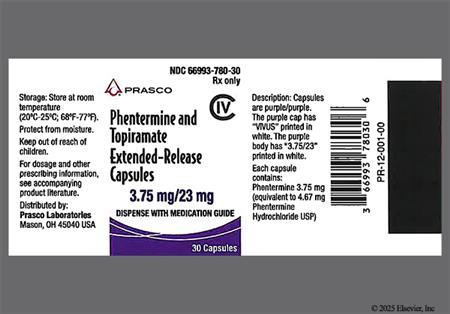
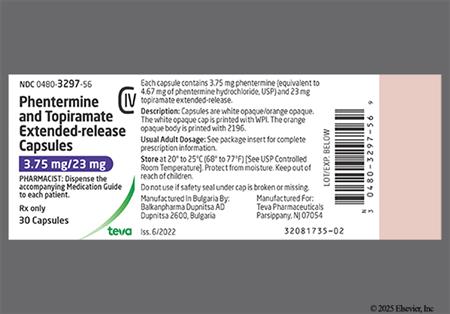

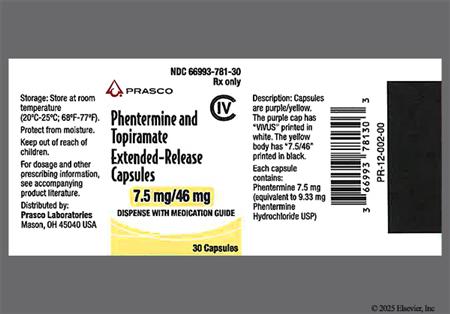
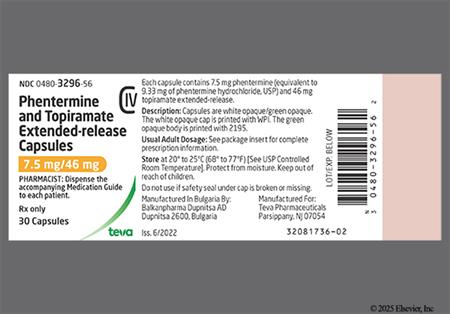
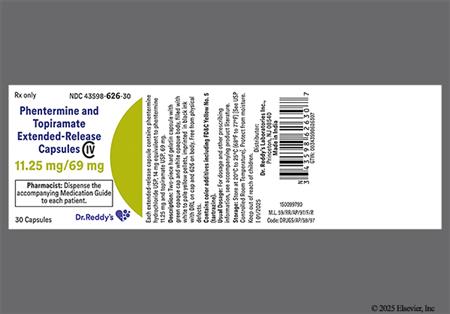
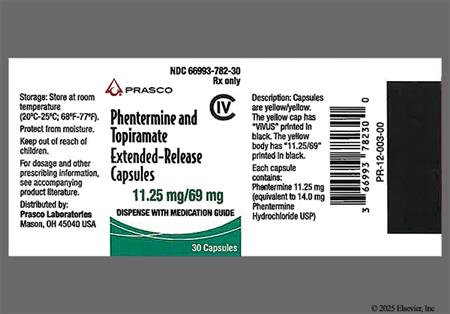
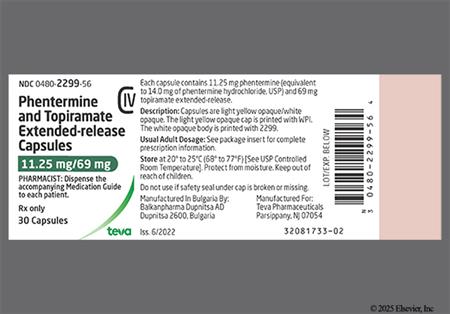
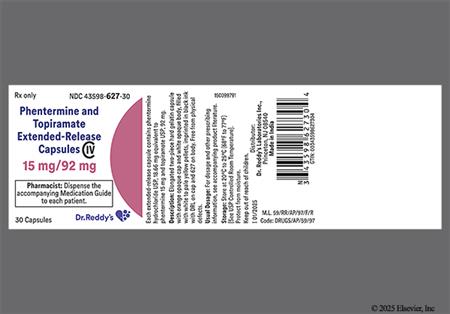
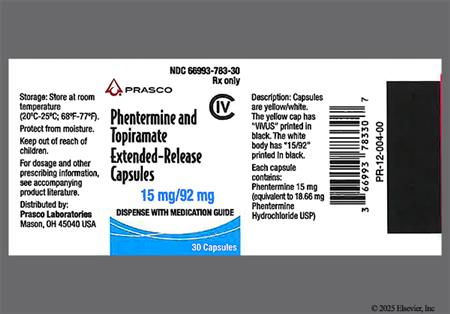

Phentermine; topiramate is a combination product containing an anorectic sympathomimetic amine (phentermine) with topiramate, an antiepileptic drug with weak carbonic anhydrase inhibitor activity whose precise role in weight reduction is not known. The combination is used as an adjunct to lifestyle modifications for weight loss and chronic weight management in adult and pediatric patients 12 years and older with obesity and in overweight adults with at least 1 weight-related comorbid condition (e.g., hypertension, type 2 diabetes mellitus, or dyslipidemia). Long-term use of this combination product has been associated with an average weight loss of about 8% to 11% in adults and a 5% to 7% decrease in BMI in pediatric patients.[51256] According to the American Association of Clinical Endocrinologists and American College of Endocrinology (AACE/ACE) Obesity Clinical Practice Guidelines, weight loss medications should be offered as chronic treatment along with lifestyle modifications to obese patients when the potential benefits outweigh the risks. Short-term pharmacotherapy has not been shown to produce longer-term health benefits and cannot be generally recommended. A generalized hierarchy for medication preferences that would apply to all obese patients cannot currently be scientifically justified. Individualized weight loss pharmacotherapy is recommended, based on factors such as the specific characteristics of each weight loss medication, the presence of weight-related complications, and the medical history of the patient.[62881] Phentermine; topiramate may cause fetal harm (i.e., an increased risk of oral clefts) and therefore the drug is only available via the Qsymia REMS program. Females of reproductive potential require pregnancy testing before initiation of treatment and routinely during treatment. Phentermine; topiramate was initially FDA approved in 2012.[51256]
For storage information, see the specific product information within the How Supplied section.
Hazardous Drugs Classification
Extended-release capsules (e.g., Qsymia)
Safety analysis of phentermine; topiramate included 2,318 adult and 223 pediatric patients. Cardiovascular adverse reactions reported for adults receiving placebo compared to increasing doses of phentermine; topiramate (3.75 mg/23 mg, 7.5 mg/46 mg, and 15 mg/92 mg, respectively) included: chest discomfort (0.4% vs. 2.1%, 0.2%, and 0.9%) and palpitations (0.8% vs. 0.8%, 2.4%, and 1.7%). The effects of phentermine; topiramate on blood pressure were assessed in a randomized, double-blind, 3-arm 8-week study of adults with obesity or overweight and at least 1 weight-related comorbidity. In the study, phentermine; topiramate doses of 15 mg/92 mg did not demonstrate a pressor effect. During clinical evaluations, a greater number of patients receiving phentermine; topiramate experienced an increased heart rate (sinus tachycardia), with increases from baseline of more than 5, 10, 15, and 20 beats per minute, compared to placebo. The clinical significance of a heart rate elevation with treatment is unclear. It is not known if phentermine; topiramate changes the risk of cardiovascular outcomes or stroke or of death due to heart problems or stroke.[51256] Phentermine monotherapy has been associated with hypertension and cardiovascular ischemic events, such as chest pain (unspecified), in postmarketing reports.[46595]
Safety analysis of phentermine; topiramate included 2,318 adult patients and 223 pediatric patients. Adverse reactions reported for patients receiving placebo compared to increasing doses of phentermine; topiramate (3.75 mg/23 mg, 7.5 mg/46 mg, and 15 mg/92 mg, respectively) included: anxiety (2% placebo vs. 3%, 2%, and 3% to 4%), depression (2% vs. 3%, 2% to 3%, and 4%), insomnia (5% vs. 5%, 6%, and 9%), and irritability (1% vs. 2%, 3%, and 4%). Mood and sleep disorder adverse reactions were reported in patients with and without a history of depression. Anticonvulsants, including topiramate, are thought to carry an increased risk of suicidal ideation and behavior. During clinical trials in pediatric patients 12 years and older, 0.6% of phentermine; topiramate treated patients reported suicidal ideation and behavior which required hospitalization versus 0% in placebo-treated patients. Suicidal ideation and behavior has also been reported during postmarketing experience. Patients and caregivers should be informed of the increased risk of suicidal thoughts and behaviors and should be advised to immediately report the emergence or worsening of depression, the emergence of suicidal thoughts or behavior, thoughts of self-harm, or other unusual changes in mood or behavior.[51256] When used alone for weight control, CNS reactions reported with phentermine have included overstimulation, restlessness, insomnia, euphoria, dysphoria, and psychosis.[46595]
Safety analysis of phentermine; topiramate included 2,318 adult patients and 223 pediatric patients. Ophthalmic adverse reactions reported for patients receiving placebo compared to increasing doses of phentermine; topiramate (3.75 mg/23 mg, 7.5 mg/46 mg, and 15 mg/92 mg, respectively) included: blurred vision (3.5% vs. 6.3%, 4%, and 5.4%), ocular pain (1.4% vs. 2.1%, 2.2%, and 2.2%), and xerophthalmia (0.8% vs. 0.8%, 1.4%, and 2.5%). Blurred vision was listed among adverse events leading to treatment discontinuation. In addition, topiramate alone has been associated with maculopathy during postmarketing surveillance. Further, topiramate alone has been associated with the onset of acute myopia associated with secondary angle closure glaucoma. Symptoms include acute onset of decreased visual acuity and/or ocular pain. Ophthalmologic findings can include myopia, mydriasis, anterior chamber shallowing, ocular hyperemia (redness), choroidal detachments, retinal pigment epithelial detachments, macular striae, and increased intraocular pressure (ocular hypertension). This syndrome may be associated with supraciliary effusion resulting in anterior displacement of the lens and iris, with secondary angle closure glaucoma. Visual field defects, independent of elevated intraocular pressure, have been reported in clinical trials and in postmarketing experience in patients receiving topiramate. Patients with preexisting ocular disease should initiate treatment with extreme caution and monitor for symptoms of increased intraocular pressure. Symptoms typically occur within 1 month of initiating topiramate treatment, but may occur at any time during therapy. The primary treatment to reverse symptoms is immediate discontinuation.[51256]
Safety analysis of phentermine; topiramate included 2,318 adult patients and 223 pediatric patients. Musculoskeletal adverse reactions reported for adult patients receiving placebo compared to increasing doses of phentermine; topiramate (3.75 mg/23 mg, 7.5 mg/46 mg, and 15 mg/92 mg, respectively) included: back pain (5.1% vs. 5.4%, 5.6%, and 6.6%), muscle cramps (2.2% vs. 2.9%, 2.8%, and 2.9%), musculoskeletal pain (1.2% vs. 0.8%, 3%, and 1.6%), neck pain (1.3% vs. 1.3%, 2.2%, and 1.2%), and pain in extremity (2.8% vs. 2.1%, 3%, and 3%). Musculoskeletal chest pain (0% with placebo, 0% with 7.5 mg/46 mg, and 3% with 15 mg/92 mg), arthralgia (0% with placebo, 2% with 7.5 mg/46 mg, and 4% with 15 mg/92 mg), and ligament sprain (0% with placebo, 4% with 7.5 mg/46 mg, and 2% with 15 mg/92 mg) were reported in pediatric patients receiving phentermine; topiramate.[51256]
Safety analysis of phentermine; topiramate included 2,318 adult patients and 223 pediatric patients. Dermatological adverse reactions reported for adult patients receiving placebo compared to increasing doses of phentermine; topiramate (3.75 mg/23 mg, 7.5 mg/46 mg, and 15 mg/92 mg, respectively) included: rash (2.2% vs. 1.7%, 2%, and 2.6%) and alopecia (0.7% vs. 2.1%, 2.6%, and 3.7%). Postmarketing, phentermine alone has been associated with urticaria; topiramate alone has been associated with bullous rash (including erythema multiforme, Stevens-Johnson syndrome [SJS], and toxic epidermal necrolysis [TEN]) and pemphigus. Discontinue phentermine; topiramate at the first sign of a rash unless clearly not drug related. Do not resume use and consider alternative therapy if signs or symptoms suggest SJS or TEN.[51256]
Phentermine; topiramate has been associated with metabolic acidosis due to the carbonic anhydrase inhibitor activity of topiramate. In clinical studies, the incidence of persistent treatment-emergent decreases in serum bicarbonate below the normal range (less than 21 mEq/L at 2 consecutive visits or at the final visit) for patients receiving placebo compared to increasing doses of phentermine; topiramate (7.5 mg/46 mg and 15 mg/92 mg) was 2.1% vs. 6.4%, and 12.8%, respectively; the incidence of persistent, markedly low serum bicarbonate values (less than 17 mEq/L on 2 consecutive visits or at the final visit) was 0.1% vs. 0.2% and 0.7%, respectively. In a pediatric clinical trial, 60% to 70% of phentermine; topiramate treated patients experienced a persistent bicarbonate below the normal range (less than 21 mEq/L) compared to 43% of placebo-treated patients. Generally, decreases in serum bicarbonate occurred early in treatment (4-week visit), however severe decreases and decreases later in treatment occurred. A correction of bicarbonate by week 56 was observed in most subjects. It is therefore prudent to measure baseline and periodic serum bicarbonate, along with other serum chemistries during therapy. If persistent metabolic acidosis develops, reduce the dose or taper to discontinue the dose.[51256]
Safety analysis of phentermine; topiramate included 2,318 adult patients and 223 pediatric patients. Commonly reported gastrointestinal adverse reactions occurring at a rate of 5% or more in adults included dysgeusia, constipation, and xerostomia. Reports of dysgeusia were characterized as a metallic taste. Only phentermine; topiramate-treated patients discontinued treatment due to dysgeusia (0.6%). Adverse reactions reported for patients receiving placebo compared to increasing doses of phentermine; topiramate (3.75 mg/23 mg, 7.5 mg/46 mg, and 15 mg/92 mg, respectively) included: constipation (6.1% vs. 7.9%, 15.1%, and 16.1%), diarrhea (4.9% vs. 5%, 6.4%, and 5.6%), dysgeusia (1.1% vs. 1.3%, 7.4%, and 9.4%), dyspepsia (1.7% vs. 2.1%, 2.2%, and 2.8%), gastroenteritis (2.2% vs. 0.8%, 2.2%, and 2.5%), gastroesophageal reflux (1.3%, vs. 0.8%, 3.2%, and 2.6%), nausea (4.4% vs. 5.8%, 3.6% to 4%, and 4% to 7.2%), oral paresthesias (0.3% vs. 0.4%, 0.6%, and 2.2%), and xerostomia (2.8% vs. 6.7%, 13.5%, and 19.1%). Upper abdominal pain was reported in 3% of pediatric patients receiving phentermine; topiramate 15 mg/92 mg. Postmarketing, topiramate alone has been associated with pancreatitis, hepatic failure (including fatalities), and hepatitis.[51256]
Safety analysis of phentermine; topiramate included 2,318 adult patients and 223 pediatric patients. Commonly reported nervous system adverse reactions occurring at a rate of 5% or more in adults included paraesthesia and dizziness. Reports of paresthesia were characterized as tingling in hands, feet, or face. Only phentermine; topiramate-treated patients discontinued treatment due to paresthesias (1%). Headache and dizziness were also listed among events leading to discontinuation. Adverse reactions reported for patients receiving placebo compared to increasing doses of phentermine; topiramate (3.75 mg/23 mg, 7.5 mg/46 mg, and 15 mg/92 mg, respectively) included: disturbance in attention (0.6% vs. 0.4%, 2%, and 3.5%), dizziness (3.4% vs. 2.9%, 2% to 7.2%, and 4% to 8.6%), headache (9.3% vs. 10.4%, 7%, and 10.6%), hypoesthesia (1.2% vs. 0.8%, 3.6%, and 3.7%), and paraesthesia (1.9% vs. 4.2%, 2% to 13.7%, and 3% to 19.9%). Impaired cognition was reported in 5% and 7.6% of patients receiving phentermine; topiramate 7.5 mg/46 mg and 15 mg /92 mg, respectively, compared to 1.5% of patients receiving placebo and was comprised primarily of reports of problems with attention/concentration, memory impairment, and language (word finding). These events occurred at any time during treatment. Postmarketing, phentermine alone has been associated with tremor.[51256]
Safety analysis of phentermine; topiramate included 2,318 adult patients and 223 pediatric patients. Respiratory related adverse reactions reported for patients receiving placebo compared to increasing doses of phentermine; topiramate (3.75 mg/23 mg, 7.5 mg/46 mg, and 15 mg/92 mg, respectively) included: bronchitis (4.2% vs. 6.7%, 4.4%, and 5.4%), cough (3.5% vs. 3.3%, 3.8%, and 4.8%), influenza (4.4% vs. 7.5%, 4% to 4.6%, and 2% to 4.4%), nasal congestion (1.4% vs. 1.7%, 1.2%, and 2%), naso-pharyngitis (8% vs. 12.5%, 10.6%, and 9.4%), pharyngolaryngeal pain (2% vs. 2.5%, 1.2%, and 2.3%), sinus congestion (2% vs. 2.5%, 2.6%, and 2%), sinusitis (6.3% vs. 7.5%, 6.8%, and 7.8%), and upper respiratory tract infection (12.8% vs. 15.8%, 12.2%, and 13.5%). Fever (2% with placebo, 2% with 7.5 mg/46 mg, and 4% with 15 mg/92 mg) and ear infection (0% with placebo, 2% with 7.5 mg/46 mg, and 3% with 15 mg/92 mg) were reported in pediatric patients receiving phentermine; topiramate.[51256]
Safety analysis of phentermine; topiramate included 2,318 adult patients and 223 pediatric patients. Genitourinary adverse reactions reported for adult patients receiving placebo compared to increasing doses of phentermine; topiramate (3.75 mg/23 mg, 7.5 mg/46 mg, and 15 mg/92 mg, respectively) included: dysmenorrhea (0.2% vs. 2.1%, 0.4%, and 0.8%) and urinary tract infection (3.6% vs. 3.3%, 5.2%, and 5.2%). Nephrolithiasis was reported in 0.2% and 1.2% of patients receiving phentermine; topiramate 7.5 mg/46 mg and 15 mg/92 mg, respectively, compared to 0.3% of patients receiving placebo. An increase in urinary calcium and marked decrease in urinary citrate, which is associated with an increased risk of nephrolithiasis and/or nephrocalcinosis, has been reported in pediatric patients treated with topiramate. Postmarketing, phentermine alone has been associated with impotence (erectile dysfunction), and changes in libido (libido increase and libido decrease).[51256]
Safety analysis of phentermine; topiramate included 2,318 adult patients and 223 pediatric patients. General adverse reactions reported for patients receiving placebo compared to increasing doses of phentermine; topiramate (3.75 mg/23 mg, 7.5 mg/46 mg, and 15 mg/92 mg, respectively) included: decreased appetite (0.6% vs. 2.1%, 1.8%, and 1.5%), fatigue (4.3% vs. 5%, 4.4%, and 3% to 5.9%), procedural pain (1.7% vs. 2.1%, 2.4%, and 1.9%), and thirst (0.7% vs. 2.1%, 1.8%, and 2%). In clinical studies, increased serum creatinine was observed with peak increases after 4 to 8 weeks of treatment in adults and 16 weeks in pediatric patients. On average, serum creatinine gradually declined but remained elevated over baseline creatinine values. The incidence of increases in serum creatinine of 0.3 mg/dL or more for adult patients receiving phentermine; topiramate was 7.2% (7.5 mg/46 mg) and 8.4% (15 mg/92 mg) compared to 2%, placebo. The incidence of increases in serum creatinine of 0.3 mg/dL or more for pediatric patients treated with phentermine; topiramate 7.5 mg/46 mg or 15 mg/92 mg was 17% vs. 0%, placebo. Increases of serum creatinine of 50% or more over baseline occurred in 2% (7.5 mg/46 mg) and 2.8% (15 mg/92 mg) of adult patients receiving phentermine; topiramate compared to 0.6% receiving placebo. Measurement of serum creatinine prior to starting therapy and during treatment is recommended. If persistent elevations in creatinine occur, reduce the dose or discontinue. Topiramate alone has been associated with hyperammonemia and hypothermia; the risk for hyperammonemia appears dose related. In adolescent migraine prophylaxis trials, the incidence of hyperammonemia was 9% for placebo, 14% for topiramate 50 mg/day, and 26% for 100 mg/day. The incidence of markedly increased hyperammonemia (i.e., ammonia values at least 50% higher than the upper limit of normal) was greatest at the 100 mg dose.[51256]
Phentermine; topiramate has been associated with hypokalemia. In clinical studies, the incidence of persistent low serum potassium values (less than 3.5 mEq/L at 2 consecutive visits or at the final visit) for patients receiving placebo compared to increasing doses of phentermine; topiramate (7.5 mg/46 mg and 15 mg/92 mg) was 1.1% vs. 3.6% and 4.9%, respectively; the incidence of markedly low serum potassium (less than 3 mEq/L, and a reduction from pre-treatment of greater than 0.5 mEq/L) at any time during the trial was 0% vs. 0.2% and 0.7%, respectively; persistent markedly low serum potassium (less than 3 mEq/L, and a reduction from pre-treatment of greater than 0.5 mEq/L at 2 consecutive visits or at the final visit) occurred in 0% vs. 0.2% and 0.1%. Of the subjects who experienced persistent low serum potassium, 88% were receiving treatment with a non-potassium-sparing diuretic. Hypokalemia was not observed in a 56-week clinical trial of pediatric patients with obesity.[51256]
Physiological dependence and psychological dependence may occur in patients treated with phentermine; topiramate. For topiramate, abrupt discontinuation has been associated with seizures in patients without a history of seizures or epilepsy. For phentermine, abrupt cessation after prolonged high dosage administration results in extreme fatigue and mental depression; changes are also noted on a sleep electroencephalogram. Gradually taper phentermine; topiramate, particularly at a dose of 15 mg/92 mg once daily, to reduce the possibility of precipitating a seizure. In situations where rapid withdrawal is required, appropriate medical monitoring is recommended.[51256] Evidence-based data from the literature are relatively limited, and some experts suggest that long-term phentermine pharmacotherapy for obesity does not induce abuse or psychological dependence (addiction), drug craving, and that abrupt treatment cessation within the normal prescription dose range does not induce amphetamine-like withdrawal.[57587]
Phentermine; topiramate is associated with growth inhibition in obese pediatric patients 12 to 17 years. A lower height velocity of -1.3 to -1.4 cm/year was observed in patients receiving phentermine; topiramate in clinical trials. Additionally, phentermine; topiramate is associated with less bone mineral acquisition. In a substudy (n = 66) evaluating bone mineralization via dual-energy X-ray absorptiometry (DEXA), increases in bone mineral density (BMD) at the lumbar spine and total body less head (TBLH) were smaller in pediatric patients treated with phentermine; topiramate compared to those treated with placebo after 1 year of treatment. Declines in BMD Z-scores of -0.5 or greater from baseline for TBLH were observed in 9% of patients receiving phentermine; topiramate 7.5 mg/46mg and 30% of patients receiving 15 mg/92 mg compared to 0% of placebo-treated patients. No patient had a BMD Z-score that went below -2 during the trial.[51256]
Phentermine; topiramate is contraindicated in patients with hyperthyroidism since sympathomimetics like phentermine can exacerbate this condition.[51256]
Phentermine; topiramate is contraindicated for use in people with glaucoma. A syndrome consisting of acute myopia associated with secondary angle-closure glaucoma (closed-angle glaucoma) has been reported in pediatric patients and adults treated with topiramate. Symptoms include acute onset of decreased visual acuity and/or ocular pain. Ophthalmologic findings can include myopia, mydriasis, anterior chamber shallowing, ocular hyperemia (redness), choroidal detachments, retinal pigment epithelial detachments, macular striae, and increased intraocular pressure. This syndrome may be associated with supraciliary effusion resulting in anterior displacement of the lens and iris, with secondary angle-closure glaucoma. Symptoms typically occur within 1 month of initiating treatment with topiramate but may occur at any time during therapy. The primary treatment to reverse symptoms is immediate discontinuation of phentermine; topiramate in consultation with the treating physician. Elevated intraocular pressure of any etiology, if left untreated, can lead to serious sequelae including permanent loss of vision. Visual field defects (independent of elevated intraocular pressure) have been reported in clinical trials and in postmarketing experience in patients receiving topiramate. In clinical trials, most of these events were reversible after topiramate discontinuation. Advise patients to immediately report symptoms of severe and persistent eye pain or significant changes in their vision to their health care provider. If visual problems occur at any time during treatment, consider discontinuing phentermine; topiramate.[51256]
Avoid phentermine; topiramate therapy in people with a history of suicidal attempts or active suicidal ideation. Monitor all patients for the emergence or worsening of depression, suicidal thoughts or behavior, and/or any unusual mood or behavioral changes while taking phentermine; topiramate. Phentermine; topiramate therapy can cause mood disorders, including depression and anxiety, as well as insomnia. Patients with a history of depression may be at increased risk of recurrent depression or other mood disorders while taking this product for weight loss or weight management. Consider dosage reduction or discontinuation if clinically significant or persistent symptoms occur. Discontinue phentermine; topiramate in patients who experience suicidal thoughts or behaviors during treatment. Antiepileptic drugs (AEDs), including topiramate increase the risk of suicidal thoughts or behavior in patients taking these drugs for any indication. This increased risk with AEDs was observed as early as 1 week after starting drug treatment and persisted for the duration of treatment assessed. Because most trials did not extend beyond 24 weeks, the risk of suicidal thoughts or behavior beyond 24 weeks could not be assessed. The risk of suicidal thoughts or behavior was generally consistent among drugs in the data analyzed. The finding of increased risk with AEDs of varying mechanisms of action and across a range of indications suggests that the risk applies to all AEDs used for any indication. The risk for suicidal ideation, thoughts, or behaviors did not vary substantially by age in the clinical trials analyzed.[51256]
Phentermine; topiramate can cause cognitive dysfunction (e.g., impairment of concentration/attention, difficulty with memory, and speech or language problems, particularly word-finding difficulties). Rapid titration or high initial doses may be associated with higher rates of cognitive events such as attention, memory, and language/word-finding difficulties. Since this treatment has the potential to impair cognitive function, caution treated patients about driving or operating machinery or performing other tasks that require mental alertness until they are aware of how their mental and motor performance are affected. If cognitive impairment persists, consider dose reduction. Consider discontinuation of phentermine; topiramate for symptoms that are moderate to severe, bothersome, or which fail to resolve with dose reduction. Coadministration with other CNS depressants, including ethanol ingestion, may potentiate CNS depression or other centrally mediated effects of these agents, such as dizziness, cognitive adverse reactions, drowsiness, light-headedness, impaired coordination, and somnolence. Advise treated patients that excessive alcohol ingestion is best avoided during phentermine; topiramate treatment.[51256]
Phentermine; topiramate has been associated with metabolic acidosis. Topiramate is a carbonic anhydrase inhibitor that can promote metabolic acidosis and also hypokalemia. Certain conditions (e.g., renal disease, severe respiratory disorders/severe pulmonary disease, status epilepticus, diarrhea, surgery, or ketogenic diet) may have an additive risk for metabolic acidosis. Avoid use of phentermine; topiramate with other carbonic anhydrase inhibitors as this may increase risk for metabolic acidosis and kidney stones. Manifestations of acute or chronic metabolic acidosis may include hyperventilation, nonspecific symptoms such as fatigue and anorexia, or more severe sequelae including cardiac arrhythmias or stupor. Chronic, untreated metabolic acidosis may increase the risk for kidney stones or nephrocalcinosis and may also result in osteomalacia (rickets) and/or osteoporosis with an increased risk for bone fracture and may reduce growth rates in pediatric patients. Measure electrolytes, including serum bicarbonate, prior to starting phentermine; topiramate and during treatment. In clinical trials, the peak reduction in serum bicarbonate occurred by week 4, and in most subjects there was a correction of bicarbonate by week 56, without any change to the treatment regimen. However, if persistent metabolic acidosis develops, reduce the dose or taper to discontinue the dose.[51256]
A lower maximum daily dose of phentermine; topiramate is recommended for people with moderate (CrCl 30 to less than 50 mL/minute) and severe (CrCl less than 30 mL/minute) renal impairment. Avoid use of phentermine; topiramate in those with end-stage renal failure on dialysis. Phentermine; topiramate can cause an increase in serum creatinine that reflects a decrease in renal function (GFR). In clinical trials, peak increases in serum creatinine were observed after 4 to 8 weeks of treatment. On average, serum creatinine gradually declined but remained elevated over baseline values. The changes in serum creatinine (and measured GFR) with short-term (4-weeks) phentermine; topiramate treatment appear to be reversible with treatment discontinuation, but the effect of chronic treatment on renal function is not known. Measure serum creatinine prior to starting phentermine; topiramate and during treatment. If persistent elevations in serum creatinine occur, reduce the dosage or discontinue treatment.[51256]
Phentermine; topiramate should be used with caution in patients with a history of kidney stones (nephrolithiasis). Topiramate has been associated with kidney stone formation. Topiramate inhibits carbonic anhydrase activity and promotes kidney stone formation by reducing urinary citrate excretion and increasing urine pH. Patients on a ketogenic diet may be at increased risk for kidney stone formation. An increase in urinary calcium and a marked decrease in urinary citrate was observed in topiramate-treated pediatric patients in a 1-year, active-controlled study. An increased ratio of urinary calcium/citrate increases the risk of kidney stones and/or nephrocalcinosis. Avoid the use of phentermine; topiramate with other drugs that inhibit carbonic anhydrase. Advise patients to increase fluid intake (to increase urinary output), which may decrease the concentration of substances involved in kidney stone formation.[51256]
Oligohidrosis (decreased sweating), infrequently resulting in hospitalization, has been reported in association with the use of topiramate. Decreased sweating and an elevation in body temperature above normal characterized these cases. Some of the cases have been reported with topiramate after exposure to elevated environmental temperatures (ambient temperature increase). The majority of the reports associated with topiramate have been in pediatric patients. Advise all patients and caregivers to monitor for decreased sweating and increased body temperature during physical activity, especially in hot weather or during strenuous exercise. Patients on concomitant medications that predispose them to heat-related disorders may be at increased risk.[51256]
Use phentermine; topiramate with caution in patients with hepatic disease, as increased phentermine exposures have been reported in subjects with mild and moderate hepatic impairment. A reduced maximum dosage is recommended for people with moderate hepatic impairment (Child-Pugh Class B, score 7 to 9). Avoid use of phentermine; topiramate in people with severe hepatic disease (Child-Pugh Class C, score 10 to 15) due to a lack of study data in these patients.[51256]
It is advisable to use phentermine; topiramate with caution in people with a known history of substance abuse, including alcoholism or drug abuse. Assess the risk of abuse prior to prescribing phentermine; topiramate as part of a weight reduction and long-term maintenance of body weight program. Phentermine is related chemically and pharmacologically to amphetamines. Amphetamines and other stimulant drugs have been extensively abused. Abuse of amphetamines and related drugs (e.g., phentermine) may be associated with impaired control over drug use and severe social dysfunction. There are reports of patients who have increased the dosage of these drugs many times higher than recommended.[51256]
Obtain a blood chemistry profile that includes blood glucose in patients with type 2 diabetes mellitus (T2DM) on antidiabetic medication prior to initiating phentermine; topiramate and periodically during treatment. Weight loss and diet modifications may result in a need for adjustments of the medication regimen in those with T2DM.[51256] [62881]
In the phentermine; topiramate clinical trials, a total of 254 (7%) of the adults studied were 65 to 69 years of age; no geriatric patients 70 years of age or older were enrolled. Clinical studies did not include sufficient numbers of patients aged 65 years and over to determine whether they respond differently from younger adults. In general, dose selection for an older adult patient should be cautious, usually starting at the low end of the dosing range, reflecting the greater frequency of decreased hepatic, renal, or cardiac function, and of concomitant disease or other drug therapy.[51256]
Due to the reproductive risk, pregnancy testing is needed in patients who may become pregnant before starting phentermine; topiramate therapy and after that, monthly pregnancy testing is necessary during treatment to identify early pregnancy. There are risks to the fetus associated with early in utero exposure to topiramate. Contraception requirements also exist; individuals of reproductive potential should use adequate and effective contraception during therapy. Topiramate can reduce the efficacy of combination oral contraceptives and is associated with an increased risk of breakthrough bleeding; have patients report any change in their bleeding patterns. However, contraceptive efficacy can be decreased even in the absence of breakthrough bleeding. If phentermine; topiramate is inadvertently used during pregnancy, or if a patient becomes pregnant while on therapy, discontinue treatment immediately and inform the patient of the potential hazard to the fetus.[51256] [62881]
Phentermine; topiramate is contraindicated during pregnancy because weight loss during pregnancy may result in fetal harm and there is embryo-fetal risk due to topiramate. Data from pregnancy registries and epidemiologic studies indicate that a fetus exposed to topiramate in the first trimester of pregnancy has an increased risk of major congenital malformations, including but not limited to cleft lip and/or cleft palate (oral clefts), and of being small for gestational age (SGA). When multiple species of pregnant animals received topiramate at clinically relevant doses, structural malformations, including craniofacial defects, and reduced fetal weights occurred in offspring. In the North American Antiepileptic Drug (NAAED) Pregnancy Registry, topiramate-exposed infants had higher rates of major congenital malformations (4.1%) compared to infants exposed to a reference antiepileptic drug (AED) (1.8%) or in infants with mothers without epilepsy and without exposure to AEDs (1.1%). The presence of oral clefts was also higher in infants exposed to topiramate (1.4%) than infants exposed to a reference AED (0.3%) or those with mothers without epilepsy and without exposure to AEDs (0.11%). Topiramate-exposed newborns were also noted to be small for gestational age (defined as less than 10th percentile for body weight) when compared to newborns on a reference AED or born to mothers without epilepsy and without AED exposure (19.7% exposed to topiramate; 7.9% exposed to reference AED; 5.4% without exposure). The Qsymia Pregnancy Surveillance Program is a maternal-fetal outcomes program which monitors pregnancies that occur during therapy; providers and patients are encouraged to report pregnancies to the program by calling 1-888-998-4887. The effect of phentermine; topiramate on labor and obstetric delivery in humans is unknown. The effect of topiramate-induced metabolic acidosis has not been studied in pregnancy; however, metabolic acidosis (from other causes) has been reported to cause decreased fetal growth, decreased fetal oxygenation, and fetal death, and may affect the ability of the fetus to tolerate labor.[51256] [62881]
Both topiramate and phentermine are present in human milk. There are no data on the effects of topiramate and phentermine on milk production. Diarrhea and somnolence have been reported in breastfed infants with maternal use of topiramate. There are no data on the effects of phentermine in breastfed infants. Due to the potential for serious adverse reactions, including changes in sleep, irritability, hypertension, vomiting, tremor, and weight loss in breastfed infants with maternal use of phentermine, breast-feeding is not recommended during phentermine; topiramate therapy.[51256]
Phentermine; topiramate are used in combination for chronic weight management. The exact mechanism of action responsible for weight reduction with this combination is not known.[51256]
Phentermine; topiramate extended-release is administered orally.[51256]
In pharmacokinetic evaluation, phentermine; topiramate extended-release (15 mg/92 mg dose) was studied in patients with varying degrees of hepatic impairment. In patients with mild (Child Pugh Class A) and moderate (Child Pugh Class B) hepatic impairment, phentermine AUC was 37% and 60% higher compared to healthy subjects. Pharmacokinetics of topiramate was not affected in patients with mild and moderate hepatic impairment. The product has not been studied in patients with severe hepatic impairment (Child Pugh Class C).[51256]
In pharmacokinetic evaluation, phentermine; topiramate extended-release (15 mg/92 mg dose) was studied in patients with varying degrees of chronic renal impairment. Drug exposures (AUCs) increased with severity of renal impairment. Compared to healthy subjects, phentermine AUC was 91%, 45%, and 22% higher in patients with severe, moderate, and mild renal impairment, respectively; phentermine Cmax was 2% to 15% higher. Compared to healthy subjects, topiramate AUC was 126%, 85%, and 25% higher for patients with severe, moderate, and mild renal impairment, respectively; topiramate Cmax was 6% to 17% higher. The product has not been studied in patients with end-stage renal disease on dialysis.[51256]
Phentermine; topiramate extended-release exposure in pediatric patients 12 years and older appears comparable to that in adults.[51256]
In clinical trials for phentermine; topiramate, a total of 254 (7%) of the patients were 65 years of age and older; specific pharmacokinetic data for the elderly have not been reported.[51256]
Phentermine; topiramate is contraindicated during pregnancy because weight loss during pregnancy may result in fetal harm and there is embryo-fetal risk due to topiramate. Data from pregnancy registries and epidemiologic studies indicate that a fetus exposed to topiramate in the first trimester of pregnancy has an increased risk of major congenital malformations, including but not limited to cleft lip and/or cleft palate (oral clefts), and of being small for gestational age (SGA). When multiple species of pregnant animals received topiramate at clinically relevant doses, structural malformations, including craniofacial defects, and reduced fetal weights occurred in offspring. In the North American Antiepileptic Drug (NAAED) Pregnancy Registry, topiramate-exposed infants had higher rates of major congenital malformations (4.1%) compared to infants exposed to a reference antiepileptic drug (AED) (1.8%) or in infants with mothers without epilepsy and without exposure to AEDs (1.1%). The presence of oral clefts was also higher in infants exposed to topiramate (1.4%) than infants exposed to a reference AED (0.3%) or those with mothers without epilepsy and without exposure to AEDs (0.11%). Topiramate-exposed newborns were also noted to be small for gestational age (defined as less than 10th percentile for body weight) when compared to newborns on a reference AED or born to mothers without epilepsy and without AED exposure (19.7% exposed to topiramate; 7.9% exposed to reference AED; 5.4% without exposure). The Qsymia Pregnancy Surveillance Program is a maternal-fetal outcomes program which monitors pregnancies that occur during therapy; providers and patients are encouraged to report pregnancies to the program by calling 1-888-998-4887. The effect of phentermine; topiramate on labor and obstetric delivery in humans is unknown. The effect of topiramate-induced metabolic acidosis has not been studied in pregnancy; however, metabolic acidosis (from other causes) has been reported to cause decreased fetal growth, decreased fetal oxygenation, and fetal death, and may affect the ability of the fetus to tolerate labor.[51256] [62881]
Both topiramate and phentermine are present in human milk. There are no data on the effects of topiramate and phentermine on milk production. Diarrhea and somnolence have been reported in breastfed infants with maternal use of topiramate. There are no data on the effects of phentermine in breastfed infants. Due to the potential for serious adverse reactions, including changes in sleep, irritability, hypertension, vomiting, tremor, and weight loss in breastfed infants with maternal use of phentermine, breast-feeding is not recommended during phentermine; topiramate therapy.[51256]
Cookies are used by this site. To decline or learn more, visit our cookie notice.
Copyright © 2025 Elsevier, its licensors, and contributors. All rights are reserved, including those for text and data mining, AI training, and similar technologies.